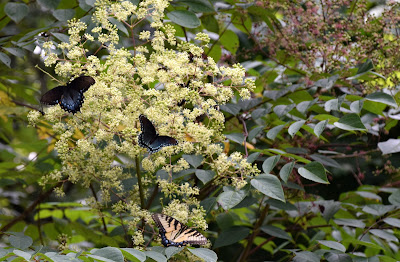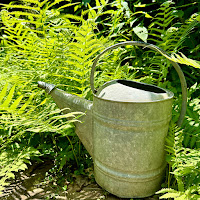As I get to know our new space, I am using this winter to
think about how I want to deal with deer this time. As I
wrote earlier, getting to know your new place before jumping into changes
is a good idea, and planning for deer will hopefully save me from sacrificing new
plant decisions to their salad bowl.
I have written about dealing with deer before; my
most recent post was in 2023 and it gives some plant suggestions. It also links
back to an earlier post in 2011. I will certainly apply all that I’ve learned into my
choices.
Those of us who live with deer get understandably
frustrated, and some people wonder how native plants should be part of our
landscaping decisions when deer are present. Since deer evolved here with native plants, are they
more prone to eat them? Would exotic plants be more resistant to their
browsing? It helps to realize that ornamental landscapes – the plants that we
scatter around our homes – are artificial constructs compared to the natural
world.
If we were to walk in this area even just 300 years ago, we’d see plants growing in colonies, or mixing with others, with some populations growing in vast abundance; some areas might be dense like a thicket. I imagine that nibbling would not have been as noticeable and plants would likely be able sustain such damage. In addition, predators would likely have pruned the deer population in turn or driven them to new areas.
Nowhere was there a small woman wringing her
hands over the damage to that one shrub next to her front door. We’re always going
to notice damage to our carefully constructed landscapes.
In
my original post in 2011, I talked about learning what they like and don’t
like, considering placement of plants, and using fences and deterrents to
protect plants. We do know that they will browse on both native and non-native
plants (know anyone with hostas or blue hydrangeas – both non-native and quite
popular with deer), so don’t bother using exotics in the hope that the deer
will ignore them.
The solution for me will be a combination of smart plant choices and some deterrence (there will always be things that I want – like native azaleas and oakleaf hydrangea –
that need protection). At my old house we had a fence around some of the
backyard (because we had a pool), so I am considering some partial fencing
around the house, leaving the rest open to nature (and smart plant choices).
Deer rub – destructive autumn behavior by male deer – is another hazard that affects any kind of sapling. Young trees and large shrubs can suffer serious damage; I've had some snapped in half while others were only scraped and able to recover. To protect saplings, install cages around the trunk.
Wish me luck and I'll report back in a year or so.












































